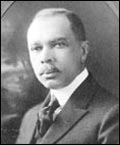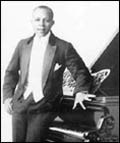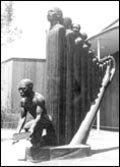Additional Audio |
|
 |
Linda Tillery, from the album Say Yo' Business |
 |
The Aeolians Choir of Oakwood College, from Lift Ev'ry Voice and Sing |
 |
The Choral Arts Society, from A Choral Tribute to Dr. Martin Luther King, Jr. |
 |
Kelli Williams, from March On |
 |
Feb. 4, 2002 -- Like a nervous father-to-be outside the delivery room, James Weldon Johnson "paced back and forth" on his front porch, "repeating the lines" of his song "over and over to myself, going through all the agony and ecstasy of creating."
That's how Johnson's autobiography describes the process of writing "Lift Every Voice and Sing," which came to be known as the black national anthem. The song is the subject of the latest segment of Present at the Creation, an NPR series on the origins of American cultural icons. Dave Person reports for Morning Edition.
The year was 1900 and Johnson was a school principal in his hometown of Jacksonville, Fla. He was asked to speak at an Abraham Lincoln birthday celebration, but instead of speaking he decided to write a poem. With time running short, plans changed again and James asked his brother, music teacher J. Rosamond Johnson, to help him write a song.
James Johnson recalled that near the end of the first stanza, when the following two lines came to him, "the spirit of the poem had taken hold of me."
Sing a song full of the faith that the dark past has taught us
Sing a song full of the hope that the present has brought us
The brothers sent the song to their New York publisher and thought little more about it. But the public found it hard to forget. Children in the South and eventually throughout the United States continued to sing it. "The lines of this song repay me in elation, almost of exquisite anguish, whenever I hear them sung by Negro children," James Johnson wrote in 1935.
And it became a popular selection for church choirs -- a tradition that continues today.
James Johnson went on to write a novel, Autobiography of an Ex-Colored Man. He also composed poetry and, with Rosamond, turned out over 200 songs for the stage. James also was appointed U.S. consul to Venezuela and later Nicaragua. In 1920, he became executive secretary of the National Association for the Advancement of Colored People. The NAACP adopted "Lift Every Voice and Sing" as its official song.
Julian Bond, the current NAACP chairman, says that even all these decades later, the song still holds deep meaning for the civil rights movement. "When people stand and sing it, you just feel a connectedness with the song, with all the people who've sung it on numerous occasions, happy and sad over the 100 years before."
Other Resources
• Read the words to "Lift Every Voice and Sing."
• Read more about James Weldon Johnson in Modern American Poetry
• Read an excerpt from Lift Every Voice and Sing, A Celebration of the Negro National Anthem; 100 Years, 100 Voices, Julian Bond and Sondra Kathryn Wilson editors
• Visit "Lift Every Voice, Music in American Life," an online exhibit at the University of Virginia Library
That's how Johnson's autobiography describes the process of writing "Lift Every Voice and Sing," which came to be known as the black national anthem. The song is the subject of the latest segment of Present at the Creation, an NPR series on the origins of American cultural icons. Dave Person reports for Morning Edition.
The year was 1900 and Johnson was a school principal in his hometown of Jacksonville, Fla. He was asked to speak at an Abraham Lincoln birthday celebration, but instead of speaking he decided to write a poem. With time running short, plans changed again and James asked his brother, music teacher J. Rosamond Johnson, to help him write a song.
James Johnson recalled that near the end of the first stanza, when the following two lines came to him, "the spirit of the poem had taken hold of me."
Sing a song full of the faith that the dark past has taught us
Sing a song full of the hope that the present has brought us
The brothers sent the song to their New York publisher and thought little more about it. But the public found it hard to forget. Children in the South and eventually throughout the United States continued to sing it. "The lines of this song repay me in elation, almost of exquisite anguish, whenever I hear them sung by Negro children," James Johnson wrote in 1935.
And it became a popular selection for church choirs -- a tradition that continues today.
James Johnson went on to write a novel, Autobiography of an Ex-Colored Man. He also composed poetry and, with Rosamond, turned out over 200 songs for the stage. James also was appointed U.S. consul to Venezuela and later Nicaragua. In 1920, he became executive secretary of the National Association for the Advancement of Colored People. The NAACP adopted "Lift Every Voice and Sing" as its official song.
Julian Bond, the current NAACP chairman, says that even all these decades later, the song still holds deep meaning for the civil rights movement. "When people stand and sing it, you just feel a connectedness with the song, with all the people who've sung it on numerous occasions, happy and sad over the 100 years before."
Other Resources
• Read the words to "Lift Every Voice and Sing."
• Read more about James Weldon Johnson in Modern American Poetry
• Read an excerpt from Lift Every Voice and Sing, A Celebration of the Negro National Anthem; 100 Years, 100 Voices, Julian Bond and Sondra Kathryn Wilson editors
• Visit "Lift Every Voice, Music in American Life," an online exhibit at the University of Virginia Library


James Weldon Johnson referred to his song as the "Negro National Hymn."
Photo: Yale Collection of American Literature, Beinecke Rare Book and Manuscript Library
 J. Rosamond Johnson wrote the music for Lift Every Voice.
J. Rosamond Johnson wrote the music for Lift Every Voice.Photo: Yale Collection of American Literature, Beinecke Rare Book and Manuscript Library
 Augusta Savage's The Harp was inspired by "Lift Every Voice and Sing."
Augusta Savage's The Harp was inspired by "Lift Every Voice and Sing."Photo: Beinecke Rare Book and Manuscript Library